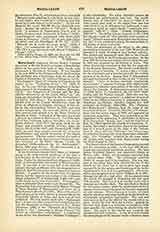

Marcus Eremita (Markos o eremites, or monachos, or asketes), a theologian and ascetic writer of some importance in the fifth century. Various theories about his period and works have been advanced. These seem now to be supplanted by J. Kunze in his study of this writer.
According to Kunze, Mark the Hermit was superior of a laura at Ancyra; he then as an old man left his monastery and became a hermit, probably in the desert east of Palestine, near St. Sabas. He was a contemporary of Nestorius and died probably before the Council of Chalcedon (451). Nicephorus Callistus (fourteenth century) says he was a disciple of St. John Chrysostom (“IRA. Eccl.” in P.G., CXLVI, XIV, 30). Cardinal Bellarmine [de Script. eccl. (1631), p. 273] thought that this Mark was the monk who prophesied ten more years of life to the Emperor Leo VI in 900. He is refuted by Tillemont [Memoires (1705), X, 456 sq.]. Another view supported by the Byzantine “Menaia” (Acta Sanct., March 1) identifies him with the Egyptian monk mentioned in Palladius, “Historia Lausiaca”, XX (P.G., XXXII), who lived in the fourth century. The discovery and identification of a work by him against Nestorius by P. Kerameus in his Analekta ierosol. stachuologias (St. Petersburg, 1891), I, pp. 89-113, makes his period certain, as defended by Kunze.
Mark’s works are: (I) Of the spiritual law; (2) Concerning those who think to be justified through works (both ascetic treatises for monks); (3) Of penitence; (4) Of baptism; (5) To Nicholas on refraining from anger and lust; (6). Disputation against a scholar (against appealing to civil courts and on celibacy); (7) Consultation of the mind with its own soul (reproaches that he makes Adam, Satan, and other men responsible for his sins instead of himself); (8) On fasting and humility; (9) On Melchisedek (against people who think that Melchisedek was an apparition of the Word of God). All the above works are named and described in the “Myrobiblion” (P.G., CIII, 668 sq.) and are published in Gallandi’s collection. To them must be added: (10) Against the Nestorians (a treatise against that heresy arranged without order). Mark is rather an ascetic than a dogmatic writer. He is content to accept dogmas from the Church; his interest is in the spiritual life as it should be led by monks. He is practical rather than mystic, belongs to the Antiochene School and shows himself to be a disciple of St. John Chrysostom.
ADRIAN FORTESCUE

